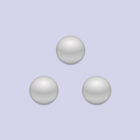Table of contents:
Silver: General Questions- Do silver nanoparticles oxidize?
- Are your silver nanoparticles amorphous or crystalline?
- Do silver nanoparticles have antimicrobial properties?
- How do I tell if the silver nanoparticles that I've purchased have gone bad?
- Do you offer "bare" or "uncapped" silver nanoparticles?
- For questions about our small PVP-capped silver nanoparticles, please click here.
- What surface coatings are available for silver nanoplates?
- Why are the plates delivered in a borate buffer instead of pure water?
- How do I store and handle my silver nanoplates?
- Why is my nanoplate peak wavelength resonance different than the value on your specification sheet?
- I’d like a nanoplate with a different resonance or a different surface. Are these available?
Silver: General Questions
Do silver nanoparticles oxidize?
Yes, silver will oxidize in the presence of sulfur and oxygen. Please see our Guidelines for Nanotoxicology Researchers Using nanoComposix Materials for additional details.
Are your silver nanospheres amorphous or crystalline?
We consider our silver nanospheres to be polycrystalline, as can be seen by the different lines and contrasts of the particles in TEM images. It is the nature of silver nanoparticles to have the silver atoms reduce into a somewhat regular crystal structure since it is a more stable form, even if it subdivides into many crystal domains within the same particle. By having numerous crystal domains, the particles are able to maintain a near spherical shape. These crystal domains can sometimes be seen as lines in the particles or patches that are darker than the rest of the particle.
Do silver nanoparticles have antimicrobial properties?
Yes, recent research has demonstrated that silver ions are an effective antimicrobial yet have low toxicity for humans. Silver nanoparticles are garnering increasing attention for their antiviral properties and are being investigated for various applications in the medical field. For more information, visit our page about Antimicrobial Silver Nanoparticles.
How do I tell if the silver nanoparticles that I've purchased have gone bad?
Well-dispersed silver nanoparticles typically have a yellow color in solution and a distinct plasmon resonance. Monitoring the UV-Visible signature of silver nanoparticles over time is a good method of ensuring that the particles are still "good". If there is a destabilization event, the color will usually change dramatically and it is clear that the particles have aggregated.
Do you offer "bare" or "uncapped" silver nanoparticles?
We frequently receive inquiries from customers asked for nanoparticles with bare surfaces. It is important to recognize that all nanoparticles require some type of capping agent or stabilizer on the surface, as truly "bare" nanoparticles would remain stable for only a few seconds before irreversibly aggregating. This is because nanoparticles can be stabilized by two forces: electrostatic repulsion (capping agents are charged, and therefore nearby particles repel each other before van der Waals forces can pull them together), or steric repulsion (the capping agent is large enough that it physically gets in the way of van der Waals forces pulling them together.
However, our citrate and tannic acid capping agents are designed such that they can be displaced by other capping agents. Tannic acid nanoparticles are more stable than citrate coated nanoparticles at high concentrations, and tannic acid can be displaced by reactive groups with high affinity for the gold particle surface. Citrate capped nanoparticles are more stable than tannic capped nanoparticles in higher ionic strength solutions, and are the best choice when using physisorption for subsequent surface modification. For more information regarding our standard capping agents, please visit our Surfaces course listings.
For questions about our small PVP-capped silver nanoparticles, please click here.Silver Nanoplates
What surface coatings are available for silver nanoplates?
Silver nanoplates are available with a variety of capping ligands and coatings. To increase stability and to maintain consistency with other nanoComposix silver nanoparticles for comparative purposes, our standard silver nanoplates are available with either a polyvinylpyrrolidone (PVP, MW = 40 k) capping agent (suspended in a 5mM sodium borate buffer) or coated with a ~15 nm silica shell (suspended in a 10 mM sodium bicarbonate buffer). Plates are also available with polyvinyl alcohol (PVA) or sodium citrate capping agents, or other capping agents as a custom order.
Why are the plates delivered in a borate buffer instead of pure water?
Due to the nanoplates’ inherent sensitivity to their environment, we prefer to provide the nanoplates in a borate buffer to prevent etching during shipping and long-term storage. If this is not suitable for your application, please contact us to discuss other solvent possibilities, including the fabrication of nanoplates that are soluble in organic solvents.
How do I store and handle my silver nanoplates?
Plates are particularly sensitive to environmental conditions (as compared to spherical silver) because the high surface energy associated with sharp edges and corners at the atomic scale causes the silver ions to be considerably more labile and prone to etching by species in the surrounding media or atomic rearrangement. Generally speaking, exposure to light, oxygen, chloride or other halogen ions, solution pH, and temperatures all influence the rate at which the nanoplates ripen or etch, and the rate at which silver ions are released into solution. This change in nanoplate morphology and size can be detected visually and spectroscopically, manifested as a blue-shift in the nanoplate plasmon resonance. To curb this shift, we have performed extensive stability studies on our silver nanoplates in various buffers and capping agents to maximize their stability. We now offer our silver nanoplates in a 5 mM sodium borate buffer instead of Milli-Q water, which nearly eliminates this blue-shift. When not in use, we recommend that the nanoplates should be stored away from light at 4°C.
Why is my nanoplate peak wavelength resonance different than the value on your specification sheet?
At the nanoscale, the size and shape of particles can change over time. Typically this is due to reorganization of the atoms within the particle. Since the plasmon resonance is so sensitive to aspect ratio, even low rates of dissolution can cause a noticeable shift in the peak resonant wavelength.
I’d like a nanoplate with a different resonance or a different surface. Are these available?
We can make nanoplates with resonant wavelengths from 500–1300 nm and with polyvinyl alcohol (PVA) or sodium citrate capping agents. Silver nanoplates with other optical properties, sizes, or different surface capping agents are available as a custom order. Contact us for more information about our custom fabrication abilities.



